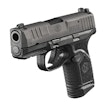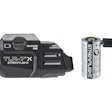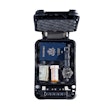Despite the howls of protest and dire predictions that continue to emanate from the traditionalists among us, I believe I am on firm ground when I state that polymer-frame pistols are not only here to stay, but will continue to capture an increasing share of the U.S. police market. In fact, it has recently been estimated that the holsters of more than 60 percent of American LEOs now contains a “plastic pistol.” And the number continues to grow. The reasons for this popularity can be explained in a few words: weight, ergonomics, environmental resistance, magazine capacity, and ease of operation.
In 1999, IM Metal Corp. of Croatia introduced its polymer-frame HS-2000 pistol, which was such an attractive package that Springfield Armory contracted to market it in the United States. After some minor cosmetic changes, it was introduced as the Springfield Armory X-treme Duty Pistol, better known simply as the XD. Now it’s available in .45 ACP.
The XD pairs an injection-molded polymer frame with a solid steel slide. Because of the frame’s propensity to flex under recoil, it absorbs some of the recoil pulse, providing a very soft-shooting pistol. It features Springfield’s high-tech Bruniral finish to provide enhanced protection from wear, salts, solvents, and the elements. But one of the main selling points is still its polymer construction.
Plastic All Grown Up
It doesn’t take a rocket scientist to figure out that a polymer frame weighs less than one made from steel or alloy. When you have to pack a handgun around on your waist eight to 12 hours a day, light weight is a big plus. The use of polymer allows the manufacturer to mold the pistol frame into a variety of shapes that suit the human hand. Also, polymer frames do not require separate grip panels, greatly reducing the girth of said frame and making it more adaptable to officers with medium or smaller hands.
Unlike steel or aluminum alloy, polymer doesn’t scratch, chip, bend, or break. To put it in simpler terms, it’s damn tough stuff. Rain, sea spray, perspiration, oils, solvents—and if you happen to be a K-9 officer, an “accident” by your canine companion—won’t have a deleterious effect on the frame. The aforementioned slim grip allows the use of a high-capacity magazine without increasing the girth of the grip.
Also, the vast majority of polymer-frame pistols on the market today use some variation of the double-action-only trigger that provides the same stroke for each shot and, normally, does not require manual safeties, hammer drop levers, and other devices. In other words, the drill is, “Draw pistol, aim, and fire. When you’re done shooting, removing your finger from inside the trigger guard renders the pistol safe.”
Yup, from the viewpoint of modern law enforcement, the polymer-frame pistol has a lot going for it. As does the new XD-45ACP.
The XD Family
Springfield Arms’ XD-45ACP is built on the XD model. The XD locks by means of the barrel hood moving up into and bearing on the front edge of the ejection port. When the pistol is fired, the barrel and slide move together a short distance, before the barrel drops down on a frame-mounted locking block, permitting the slide to continue rearward, extracting and ejecting the spent cartridge case. As the recoil spring pulls the slide forward, it strips the next round out of the magazine and chambers it. When the slide goes into battery, the barrel is cammed up, whereupon its hood enters the ejection port and locks the two units together.
Safeties include a firing pin plunger that locks the striker until the trigger is pulled through a complete stroke; a trigger safety that prevents accidental movement until purposely manipulated by the trigger finger; and a grip safety, which securely locks the sear until depressed. In addition, there is a loaded chamber indicator on top of the slide and, when cocked, the end of the striker extends past the rear of the slide. Both provide visual and tactile indications of the pistol’s condition.
The XD uses what Springfield refers to as its USA (Ultra Safe Assurance) trigger system. This requires a rather long—but very light—trigger stroke, which overcomes the trigger and firing pin safeties before it trips the sear and releases the striker to fire the pistol. The XD line includes Sub-Compact, Service, and Tactical (long slide) models with choices of standard, Tritium night, and adjustable sights. Slide finishes include black or bright nickel Teflon, and you can shoose from black- or olive drab-colored frames. All models of the XD come with a Picatinny-type rail for mounting lights or laser sights.
Until recently, Springfield offered the XD chambered for the 9mm Parabellum, .357 SIG, .40 S&W, and .45 GAP. Unfortunately, the latter cartridge has had a slow time finding its market niche. Wanting a large caliber pistol in their line, the folks at Springfield decided to offer the XD chambered for America’s favorite big bore pistol round, the .45 ACP.
[PAGEBREAK]
New Gun in Town
Naturally, this required the design to be slightly upsized and the resulting XD-45ACP pistol is, respectively, five and three ounces heavier than its 9mm and .40 caliber brethren, and a mere quarter of an inch longer. The staged column, steel magazines hold 13 rounds of .45 ACP ammunition and are tapered toward the top so as to provide the reliability of single-column feed. Their shape and a generously sized magazine well opening ensure smooth, snag-free reloads while the witness holes are most convenient when it comes to loading.
Over the past few years I have used several models of the XD for concealed carry and competition shooting and have come to have a high opinion of their reliability, accuracy, and user-friendly characteristics. Accordingly, when I heard about the new big bore XD I asked Springfield’s Debbie Williams if I might borrow one to T&E for Police.
A few weeks after the 2006 SHOT Show I received a package containing an XD-45ACP Tactical model, which differs from the standard Service model in being fitted with a five-inch barrel and longer slide. To my way of thinking, this model’s longer sight radius provides better accuracy, superior recoil control, and higher muzzle velocity without sacrificing anything in the way of portability to its slightly shorter cousin. These features would be welcome for holster carry by uniformed officers or when used by a Tactical/SWAT unit.
Despite its slightly larger size, the grip still displayed the ergonomics the XD is famous for. It fit my hand very comfortably and, when I brought the pistol up to eye level, the sights were aligned on just what I was looking at! In my opinion, this grip is one of the pistol’s most attractive features and is superior to those on high-capacity .45 ACP pistols offered by other manufacturers. Because of its USA trigger system, the only external controls are the slide release, take down lever, and ambidextrous magazine release buttons.
Shooting the XD-45ACP
With the help of my friend Butch Simpson, a recently retired EMT, I ran the XD-45ACP through the mandatory accuracy testing protocol by firing five-shot groups with four different brands of ammunition from a rest at 15 yards, the results of which are listed on the chart below. It would appear that the sights were regulated at the factory for the traditional 230-grain bullet, as both the Remington and Black Hills loads printed to point of aim and produced matching 1.675-inch groups.
We then set up a pair of D-1 targets and, using the XD Gear System holster and mag pouch that came with the pistol, Butch and I took turns running it through a series of offhand drills at distances ranging from “reach out and touch someone” to 15 yards, firing it with both two-handed and unsupported grips.
Performance was most impressive, with few rounds wandering outside of the targets’ respective X and 10 rings. Recoil control was very good and fast, accurate, follow-up shots were easy to make. My only complaint was that after extensive firing, the residue from the muzzle blast obscured the dot on the front sight. But a quick wipe with a cloth corrected the problem and the shooting continued.
After running approximately 500 rounds through the Springfield, I feel safe in making the following half dozen observations about the XD-45ACP that I feel are mandatory when choosing a handgun for police service:
1. It proved 100-percent reliable: feeding, firing, and ejecting rounds of varying bullet weights and profiles.
2. Overall balance and “pointability” were above average for a service pistol.
3. All controls were placed where they could be manipulated without moving the pistol around in your hand.
4. Recoil control was excellent, even with +P ammunition.
5. Magazines fell free when either of the ambidextrous releases was pressed.
6. It could be disassembled quickly for cleaning.
Springfield’s XD has already garnered a respectable following among U.S. police agencies and I see no reason why the XD-45ACP won’t follow in this trend. I hope Springfield will offer a Sub-Compact version, which would be a very practical choice for use by plainclothes officers or for off-duty carry.
Disassembling the XD-45ACP
1. Remove magazine and retract slide to verify the chamber is empty.
2. Lock slide to the rear with slide stop lever.
3. Rotate takedown lever 90 degrees upward.
4. Pull trigger and then remove slide forward off the frame.
5. Push recoil spring guide rod forward slightly and lift it and spring out of the slide.
6. Push barrel forward slightly and lift out of slide.
7. Reassemble in reverse order.
Paul Scarlata has served as an auxiliary police officer and writes for several firearms publications.














